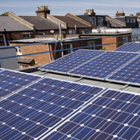
Distributed energy source networks and technologies are playing an increasingly important role in the energy portfolio. These networks can be used to meet baseload power, peaking power, backup power, remote power, power quality, as well as cooling and heating needs.
Distributed power generators are small compared with typical central-station power plants and provide unique benefits that are not available from centralized electricity generation. Many of these benefits stem from the fact that the generating units are inherently modular, which makes distributed power highly flexible. It can provide power where it is needed, when it is needed. And because they typically rely on natural gas or renewable resources, the generators can be usually made quieter as and less polluting than large power plants, which make them suitable for on-site installation in some locations. On-site installation giver distributed energy sources the potential to mitigate congestion in transmission lines, reduce the impact of electricity price fluctuations, strengthen energy security, and provide greater stability to the electricity grid. While central power generating plants will continue to provide most of the power to the grid, the distributed resources can be used to meet the peak demands of local distribution feeder lines, while reducing energy loss from long-range transmission.
There are three major barriers that need to be addressed to effectively implement a distributed energy source network, including: the impact of the distributed power sources to the integrity and reliability of the grid, communicating the cost effective benefits of distributed generation technology; the absence of proper tariff system to facilitate the trade between distribution energy suppliers and the main power utilities.